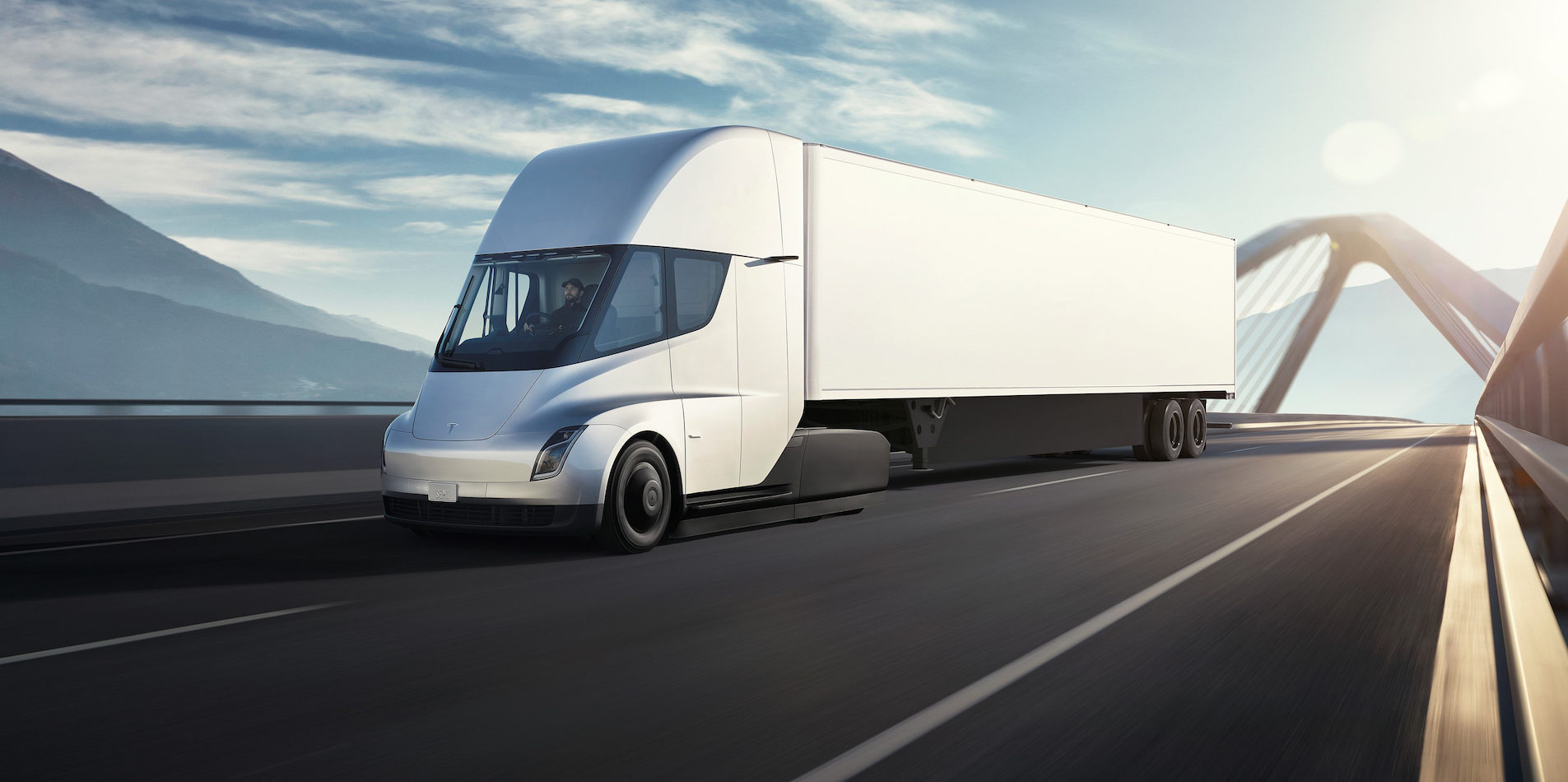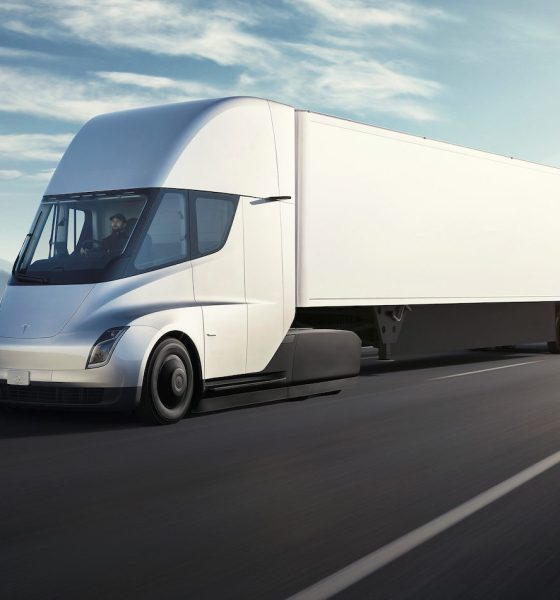

News
Tesla and rival Nikola listed among most innovative and disruptive companies in freight
This year, the FreightWaves Research Institute conducted a study aimed at determining which companies are the most innovative and disruptive in the freight and logistics industry. From 500 companies, a panel of experts selected by the institute narrowed down the list to 25. These 25 companies represented the best that the freight and logistics industry has to offer, in terms of innovation, tech, and potential disruption.
Dubbed as the Freight.Tech25, the institute’s list of top companies included freight logistics heavyweights such as Amazon and J.B. Hunt. Standing near the top of the Top 25 list was Tesla, which placed third overall. Tesla was among the few automakers that made it to the Freight.Tech25, beating out Daimler, which placed 11th in the study’s rankings. Trucking startup Nikola Motor Company, which makes hydrogen-electric trucks, placed 24th in the Top 25 list.
FreightWaves (a publication behind the institute that conducted the study) has traditionally been quite bearish on Tesla, and in particular, Elon Musk. That said, the publication notes that behind all the drama and controversy surrounding its CEO, it is undeniable that Tesla has “set much of the conversation around autonomous (technologies) and electrification, and incumbents and OEMs across the globe are chasing them.” Led by the Tesla Semi and vehicles like the Model 3, the electric car maker seems poised to be a true disruptor in the transportation and logistics field.
Speaking in a symposium, James O’Leary, VP of NFI Industries fleet services noted that the long-haul industry today is becoming very particular about electrification. The NFI Industries executive had a name for the trend — the “Tesla Effect.”
“Nobody in North America was talking about electric vehicles until your local news outlets picked up the rollout of the Tesla Semi. That led basically to what we call the Tesla effect. Now shippers are asking their carriers where you are with electric vehicles,” he said.
Another surprising automaker that made it to the Freight.Tech25 is Tesla rival Nikola Motor, a company that creates hydrogen-electric long-haulers. Considering that the startup is yet to start the production of any of its vehicles, the company’s place in the FreightWaves Research Institute’s list is commendable. The institute has noted, though, that Nikola’s tech has received rave reviews in terms of fleet pre-orders. Thanks in part to the company’s practice of accepting orders without a reservation fee, Nikola has also reportedly received over $8 billion in pre-orders for its lineup of hydrogen-electric trucks — the Nikola One sleeper, the Nikola Two daycab, and the Nikola Tre, which is designed for the European and Australian market.
In true Nikola fashion, the trucking startup has issued a bold, optimistic statement on its official Twitter page, stating that while it was great to have made it into the Freight.Tech25, the company believes in the notion that “If you ain’t first, you’re last.” As such, Nikola declared that it “will never be okay with 24th place.”
While it is nice getting in top 25, our company belief is that "If you ain't first you're last". Thank you Ricky Bobby, we agree. Nikola will never be ok with 24th place. Our only goal is #emissionsgameover https://t.co/x9Mwz6Nvvy
— Nikola Corporation (@nikolamotor) December 17, 2018
For now, Tesla continues to test the Semi on US roads, with the company’s prototypes being sighted across several states. Just recently, even the matte black Tesla Semi prototype, which has remained unseen for months, was sighted charging in the Kettleman City Supercharger. Nikola, for its part, is preparing to hold its most ambitious event this coming April, where it is set to unveil its new hydrogen-electric trucks.

Elon Musk
Starlink passes 9 million active customers just weeks after hitting 8 million
The milestone highlights the accelerating growth of Starlink, which has now been adding over 20,000 new users per day.

SpaceX’s Starlink satellite internet service has continued its rapid global expansion, surpassing 9 million active customers just weeks after crossing the 8 million mark.
The milestone highlights the accelerating growth of Starlink, which has now been adding over 20,000 new users per day.
9 million customers
In a post on X, SpaceX stated that Starlink now serves over 9 million active users across 155 countries, territories, and markets. The company reached 8 million customers in early November, meaning it added roughly 1 million subscribers in under seven weeks, or about 21,275 new users on average per day.
“Starlink is connecting more than 9M active customers with high-speed internet across 155 countries, territories, and many other markets,” Starlink wrote in a post on its official X account. SpaceX President Gwynne Shotwell also celebrated the milestone on X. “A huge thank you to all of our customers and congrats to the Starlink team for such an incredible product,” she wrote.
That growth rate reflects both rising demand for broadband in underserved regions and Starlink’s expanding satellite constellation, which now includes more than 9,000 low-Earth-orbit satellites designed to deliver high-speed, low-latency internet worldwide.
Starlink’s momentum
Starlink’s momentum has been building up. SpaceX reported 4.6 million Starlink customers in December 2024, followed by 7 million by August 2025, and 8 million customers in November. Independent data also suggests Starlink usage is rising sharply, with Cloudflare reporting that global web traffic from Starlink users more than doubled in 2025, as noted in an Insider report.
Starlink’s momentum is increasingly tied to SpaceX’s broader financial outlook. Elon Musk has said the satellite network is “by far” the company’s largest revenue driver, and reports suggest SpaceX may be positioning itself for an initial public offering as soon as next year, with valuations estimated as high as $1.5 trillion. Musk has also suggested in the past that Starlink could have its own IPO in the future.
News
NVIDIA Director of Robotics: Tesla FSD v14 is the first AI to pass the “Physical Turing Test”
After testing FSD v14, Fan stated that his experience with FSD felt magical at first, but it soon started to feel like a routine.

NVIDIA Director of Robotics Jim Fan has praised Tesla’s Full Self-Driving (Supervised) v14 as the first AI to pass what he described as a “Physical Turing Test.”
After testing FSD v14, Fan stated that his experience with FSD felt magical at first, but it soon started to feel like a routine. And just like smartphones today, removing it now would “actively hurt.”
Jim Fan’s hands-on FSD v14 impressions
Fan, a leading researcher in embodied AI who is currently solving Physical AI at NVIDIA and spearheading the company’s Project GR00T initiative, noted that he actually was late to the Tesla game. He was, however, one of the first to try out FSD v14.
“I was very late to own a Tesla but among the earliest to try out FSD v14. It’s perhaps the first time I experience an AI that passes the Physical Turing Test: after a long day at work, you press a button, lay back, and couldn’t tell if a neural net or a human drove you home,” Fan wrote in a post on X.
Fan added: “Despite knowing exactly how robot learning works, I still find it magical watching the steering wheel turn by itself. First it feels surreal, next it becomes routine. Then, like the smartphone, taking it away actively hurts. This is how humanity gets rewired and glued to god-like technologies.”
The Physical Turing Test
The original Turing Test was conceived by Alan Turing in 1950, and it was aimed at determining if a machine could exhibit behavior that is equivalent to or indistinguishable from a human. By focusing on text-based conversations, the original Turing Test set a high bar for natural language processing and machine learning.
This test has been passed by today’s large language models. However, the capability to converse in a humanlike manner is a completely different challenge from performing real-world problem-solving or physical interactions. Thus, Fan introduced the Physical Turing Test, which challenges AI systems to demonstrate intelligence through physical actions.
Based on Fan’s comments, Tesla has demonstrated these intelligent physical actions with FSD v14. Elon Musk agreed with the NVIDIA executive, stating in a post on X that with FSD v14, “you can sense the sentience maturing.” Musk also praised Tesla AI, calling it the best “real-world AI” today.
News
Tesla AI team burns the Christmas midnight oil by releasing FSD v14.2.2.1
The update was released just a day after FSD v14.2.2 started rolling out to customers.

Tesla is burning the midnight oil this Christmas, with the Tesla AI team quietly rolling out Full Self-Driving (Supervised) v14.2.2.1 just a day after FSD v14.2.2 started rolling out to customers.
Tesla owner shares insights on FSD v14.2.2.1
Longtime Tesla owner and FSD tester @BLKMDL3 shared some insights following several drives with FSD v14.2.2.1 in rainy Los Angeles conditions with standing water and faded lane lines. He reported zero steering hesitation or stutter, confident lane changes, and maneuvers executed with precision that evoked the performance of Tesla’s driverless Robotaxis in Austin.
Parking performance impressed, with most spots nailed perfectly, including tight, sharp turns, in single attempts without shaky steering. One minor offset happened only due to another vehicle that was parked over the line, which FSD accommodated by a few extra inches. In rain that typically erases road markings, FSD visualized lanes and turn lines better than humans, positioning itself flawlessly when entering new streets as well.
“Took it up a dark, wet, and twisty canyon road up and down the hill tonight and it went very well as to be expected. Stayed centered in the lane, kept speed well and gives a confidence inspiring steering feel where it handles these curvy roads better than the majority of human drivers,” the Tesla owner wrote in a post on X.
Tesla’s FSD v14.2.2 update
Just a day before FSD v14.2.2.1’s release, Tesla rolled out FSD v14.2.2, which was focused on smoother real-world performance, better obstacle awareness, and precise end-of-trip routing. According to the update’s release notes, FSD v14.2.2 upgrades the vision encoder neural network with higher resolution features, enhancing detection of emergency vehicles, road obstacles, and human gestures.
New Arrival Options also allowed users to select preferred drop-off styles, such as Parking Lot, Street, Driveway, Parking Garage, or Curbside, with the navigation pin automatically adjusting to the ideal spot. Other refinements include pulling over for emergency vehicles, real-time vision-based detours for blocked roads, improved gate and debris handling, and Speed Profiles for customized driving styles.








